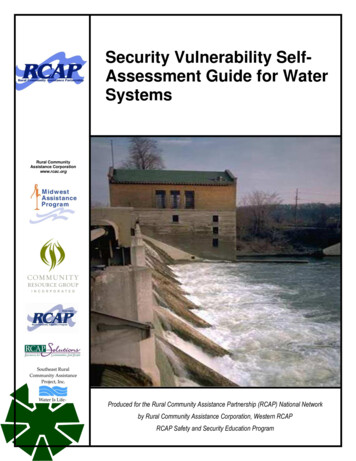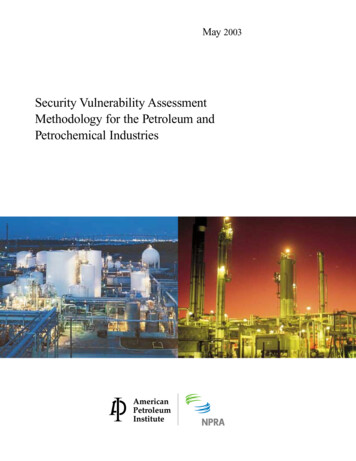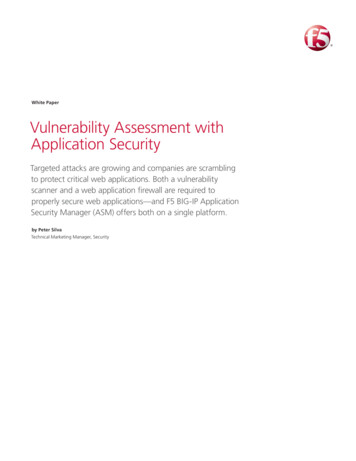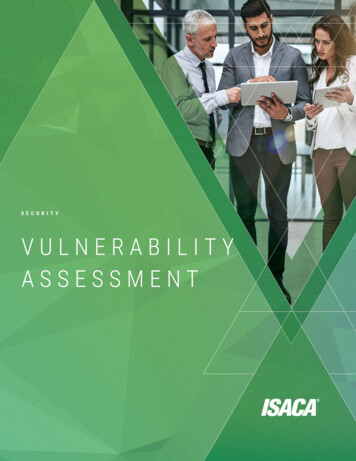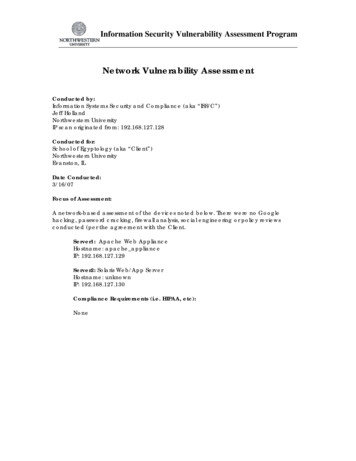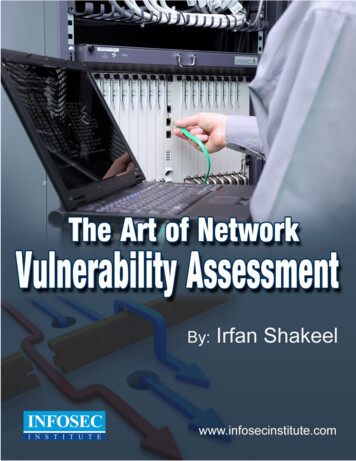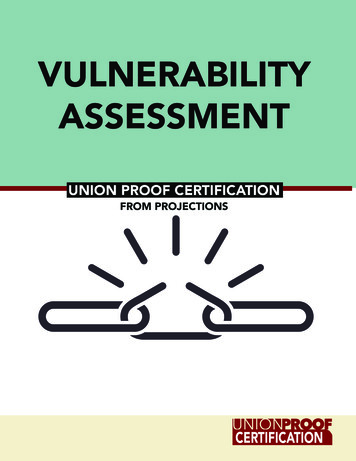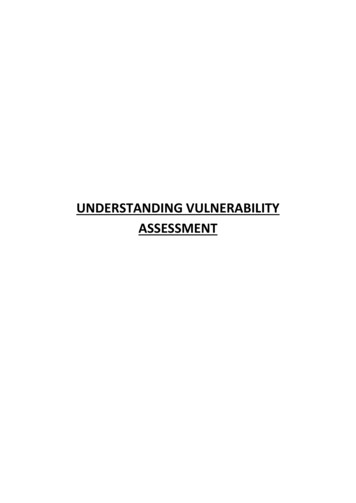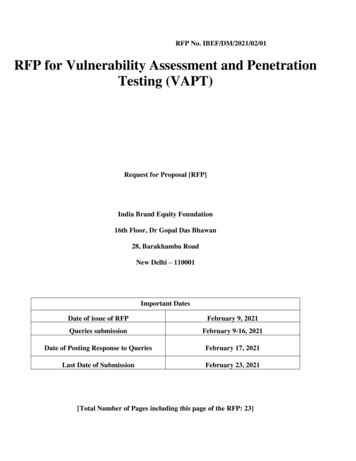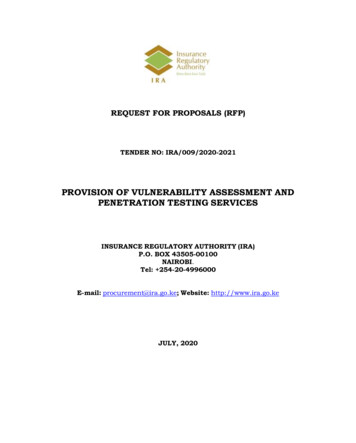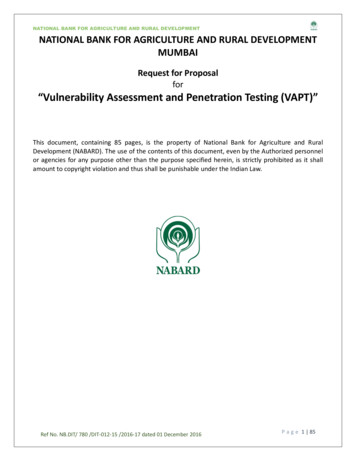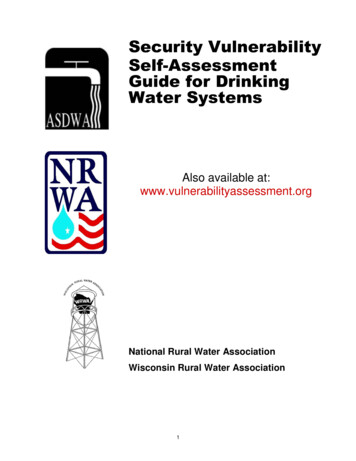
Transcription
Security VulnerabilitySelf-AssessmentGuide for DrinkingWater SystemsAlso available at:www.vulnerabilityassessment.orgNational Rural Water AssociationWisconsin Rural Water Association1
This document contains sensitiveinformation about the security of yourwater system. Therefore, it should betreated as Confidential Information andshould be stored in a secure place at yourwater system. A duplicate copy shouldalso be stored in a secure off-sitelocation.AcknowledgmentsThis document is the result of collaboration among the Association of Drinking Water Administrators(ASDWA), the U.S. Environmental Protection Agency (U.S. EPA), the U.S. EPA Drinking Water Academy,and the National Rural Water Association (NRWA). Copyright Wisconsin Rural Water Association. All rights reserved. Rev F.This template is provided for the sole and exclusive use by public water systems in Wisconsin. No part ofthis publication may be reproduced or transmitted in any form or by any means by others without theexpress written consent of the Wisconsin Rural Water Association. The information contained in thisdocument is subject to change without notice. February 4, 2004.2
ContentsSECURITY VULNERABILITY SELF-ASSESSMENT GUIDE FOR SMALL WATER SYSTEMS . 4Introduction. 4How to Use this Self-Assessment Guide . 4Before Starting this Assessment . 5Keep this Document . 5SECURITY VULNERABILITY SELF-ASSESSMENT . 6Record of Security Vulnerability Self-Assessment Completion . 6Inventory of Small Water System Critical Components . 7SECURITY VULNERABILITY SELF-ASSESSMENT FOR SMALL WATER SYSTEMS . 8General Questions for the Entire Water System . 8Water Sources . 11Treatment Plant and Suppliers . 11Distribution . 13Personnel . 14Information/Storage/Computers/Controls/Maps. 15Public Relations . 16ATTACHMENT 1. PRIORITIZATION OF NEEDED ACTIONS . 18ATTACHMENT 2. EMERGENCY CONTACT LIST . 19Section 1 System Identification . 19Section 2 Notification/Contact Information . 20Section 3 Communication and Outreach . 24ATTACHMENT 3. THREAT IDENTIFICATION CHECKLISTS . 25Water System Telephone Threat Identification Checklist . 25Water System Report of Suspicious Activity . 27CERTIFICATION OF COMPLETION . 293
Security Vulnerability Self-AssessmentGuide for Drinking Water SystemsIntroductionWater systems are critical to every community. Protection of public drinking water systems should be ahigh priority for local officials and water system owners and operators to ensure an uninterrupted watersupply, which is essential for the protection of public health (safe drinking water and sanitation) and safety(fire fighting).Adequate security measures will help prevent loss of service through terrorist acts, vandalism, or pranks.If your system is prepared, such actions may even be prevented. The appropriate level of security is bestdetermined by the water system at the local level.This Security Vulnerability Self-Assessment Guide is designed to help small water systems determinepossible vulnerable components and identify security measures that should be considered in order toprotect the system and the customers it serves. A “vulnerability assessment” (VA) is the identification ofweaknesses in water system security, focusing on defined threats that could compromise its ability tomeet its various service missions - such as providing adequate drinking water, water for firefighting,and/or water for various commercial and industrial purposes. This document is designed particularly forsystems that serve populations of 3,300 up to 10,000. This document is meant to encourage smallersystems to review their system vulnerabilities, but it may not take the place of a comprehensive review bysecurity experts. Completion of this document will meet the requirement for conducting a VulnerabilityAssessment as directed under the Public Health Security and Bioterrorism Preparedness and ResponseAct of 2002. Community Water Systems (CWSs) serving more than 3,300 and fewer than 50,000 peoplemust submit their completed vulnerability assessment to the U.S. EPA no later than June 30, 2004 inorder to meet the provisions of the Act. See page 29 for mailing and delivery instructions. You mustfollow these instructions to protect your information.The Self-Assessment Guide has a simple design. Answers to assessment questions are “yes” or “no,”and there is space to identify needed actions and actions you have taken to improve security. For any“no” answer, refer to the “comment” column and/or contact your state drinking water primacy agency.How to Use this Self-Assessment GuideThis document is designed for use by water system personnel. Physical facilities pose a high degree ofexposure to any security threat. According to the Bioterrorism Law, vulnerability assessments shouldinclude, but not be limited to, a review of pipes and constructed conveyances, physical barriers, watercollection, pretreatment, treatment, storage and distribution facilities, electronic, computer or otherautomated systems which are utilized by the public water system, the use, storage, or handling of variouschemicals, and the operation and maintenance of such system. This self-assessment should beconducted on all components of your system (wellhead or surface water intake, treatment plant, storagetank(s), pumps, distribution system, and other important components of your system).The Assessment includes a basic emergency contact list for your use; however, under the Public HealthSecurity and Bioterrorism Preparedness and Response Act of 2002, all systems serving a populationgreater than 3,300 must complete or revise an emergency response plan based on their vulnerabilityassessment. Systems must certify to the U.S. EPA Administrator that incorporates the results of the VAthat have been completed or revised within six months of submitting their vulnerability assessment to U.S.EPA. The list included as Attachment 2 will not meet the requirements of the Bioterrorism Act, but it willhelp you identify who you need to contact in the event of an emergency or threat and will help youdevelop communication and outreach procedures. You may be able to obtain sample EmergencyResponse Plans from your state drinking water primacy agency. Development of the emergencyresponse plan should be coordinated with the Local Emergency Planning Committee (LEPC).4
Security is everyone’s responsibility. This document should help you to increase the awareness of all youremployees, governing officials, and customers about security issues. Once you have completed thequestions, review the actions you need to take to improve your system’s security. The goal of thevulnerability assessment is to develop a system-specific list of priorities intended to reduce risks to threatsof attack. Make sure to prioritize your actions based on the most likely threats to your system. Once youhave developed your list of priority actions, you have completed your vulnerability assessment. Pleasecomplete the Certificate of Completion on page 29 and return only the certificate to your state drinkingwater primacy agency. Unless your state has its own requirement that the vulnerability assessments besubmitted to the state for review (e.g. New York) do not include a full copy of your self-assessment withthe certification submitted to the state primacy agency. Please check with your state drinking waterprimacy agency to find out what is required for your state. In addition, under the Bioterrorism Act allsystems serving a population greater than 3,300 and less than 50,000 must submit their completedvulnerability assessment and a Certificate of Completion to the U.S. EPA by June 30, 2004. (See page29 for instructions on how to do this.)Before Starting this AssessmentSystems should make an effort to identify critical services and customers, such as hospitals or powerfacilities, as well as critical areas of their drinking water system that if attacked could result in a significantdisruption of vital community services, result in a threat to public health, or a complete shut down of thesystem (e.g. inability to provide an adequate supply of water for fire prevention, inability to provide safepotable water, or release of hazardous chemicals that could cause catastrophic results). Whenprioritizing the potential water system vulnerabilities and consequences factor into the decision processthe critical facilities, services, and single points in the system that if debilitated could result in significantdisruption of vital community services or health protection. To help identify priorities for your system, thetable on page 7 provides a column where you can categorize the assets that you consider critical into oneof three categories – high (H), medium (M), or low (L).When evaluating a system’s potential vulnerability, systems should attempt to determine what type ofassailants and threats they are trying to protect against. Systems should contact their local lawenforcement office to see if they have information indicating the types of threats that may be likely againsttheir facility. Systems should also refer to the U.S. EPA “Baseline Threat Information for VulnerabilityAssessments of Community Water Systems” to help assess the most likely threats to their water system.This document is available to CWSs serving greater than 3,300 people. If your system has not yetreceived instructions on how to receive a copy of this document, then contact your Regional U.S. EPAOffice immediately. You will be sent instructions on how to securely access it via the Water InformationSharing and Analysis Center (ISAC) website or obtain a hard copy that can be mailed directly to you.Some of the typical threats to your facility may be vandalism, an insider (i.e. disgruntled employee), aterrorist, or a terrorist working with a system employee.Keep this DocumentThis is a working document. Its purpose is to start your process of security vulnerability assessment andsecurity enhancements. Security is not an end point, but a goal that can be achieved only throughcontinued efforts to assess and upgrade your system. This is a sensitive document. It should be storedseparately in a secure place at your water system. A duplicate copy should also be retained at a secureoff-site location. Access to this document should be limited to key water system personnel and localofficials as well as the state drinking water primacy agency and others on a need-to-know basis.5
Security Vulnerability Self-AssessmentRecord of Security Vulnerability Self-Assessment CompletionThe following information should be completed by the individual conducting theself-assessment and/or any additional revisions.Name:Title:Area ofResponsibility:Water SystemName:Water SystemPWSID:Address:City:County:State:Zip Code:Telephone:Fax:E-mail:Date Completed:Date Revised:Signature:Date Revised:Signature:Date Revised:Signature:Date Revised:Signature:Date Revised:Signature:6
Inventory of Small Water System Critical ComponentsComponentNumber &Location (ifapplicable)Source Water TypeGround WaterSurface WaterPurchasedTreatment PlantBuildingsPumpsTreatment Equipment (e.g., basin, clear well, filter)Process ControlsTreatment Chemicals and StorageLaboratory Chemicals and StorageStorageStorage TanksPressure TanksPowerPrimary PowerAuxiliary PowerDistribution SystemPumpsPipesValvesAppurtenances (e.g., flush hydrants, backflowpreventers, meters)Other Vulnerable /Work VehiclesPersonnelCommunicationsTelephoneCell PhoneRadioComputer Control Systems (SCADA)Critical Facilities ServedPower Plant FacilitiesHospitalsSchoolsWaste Water Treatment PlantsFood/Beverage Processing PlantsNursing HomesPrisons/Other Institutions7DescriptionCritical AssetorSingle Point ofFailure (H/M/L)
General Questions for the Entire Water SystemSecurity Vulnerability Self-Assessment for Small Water SystemsThe first 15 questions in this vulnerability self-assessment are general questions designed to apply to all components of your system (wellhead or surfacewater intake, treatment plant, storage tank(s), pumps, distribution system, and offices). These are followed by more specific questions that look atindividual system components in greater detail.QUESTIONANSWERCOMMENT1.Yes Under the provisions of the Public Health Security and BioterrorismPreparedness and Response Act of 2002 you are required todevelop and/or update an ERP within six months after completingthis assessment. If you do not have an ERP, you can obtain asample from your state drinking water primacy agency. As a firststep in developing your ERP, you should develop your EmergencyContact List (see Attachment 2).Do you have a writtenemergency response plan(ERP)?No ACTION NEEDED/TAKENA plan is vital in case there is an incident that requires immediateresponse. Your plan should be reviewed at least annually (or morefrequently if necessary) to ensure it is up-to-date and addressessecurity emergencies including ready access to laboratories capableof analyzing water samples. You should coordinate with your LEPC.You should designate someone to be contacted in case ofemergency regardless of the day of the week or time of day. Thiscontact information should be kept up-to-date and made available toall water system personnel and local officials (if applicable).2.Have you reviewed U.S.EPA’s Baseline ThreatInformation Document?Yes No 3.Is access to the criticalcomponents of the watersystem (i.e., a part of thephysical infrastructure of thesystem that is essential forwater flow and/or waterquality) restricted toauthorized personnel only?Yes No Share this ERP with police, emergency personnel, and your stateprimacy agency. Posting contact information is a good idea only ifauthorized personnel are the only ones seeing the information.These signs could pose a security risk if posted for public viewingsince it gives people information that could be used against thesystem.The U.S. EPA baseline threat document is available through theWater Information Sharing and Analysis Center atwww.waterisac.org. It is important you use this document todetermine potential threats to your system and to obtain additionalsecurity related information. U.S. EPA should have provided acertified letter to your system that provided instructions on obtainingthe threat document.You should restrict or limit access to the critical components of yourwater system to authorized personnel only. This is the first step insecurity enhancement for your water system. Consider the following: Issue water system photo identification cards for employees, andrequire them to be displayed within the restricted area at all times. Post signs restricting entry to authorized personnel and ensurethat assigned staff escort people without proper ID.8
QUESTIONANSWERCOMMENT4. Are all critical facilitiesfenced, including wellhousesand pump pits, and are gateslocked where appropriate?Yes Ideally, all facilities should have a security fence around theperimeter.5. Are all critical doors,windows, and other points ofentry such as tank and roofhatches and vents keptclosed and locked?Yes No No ACTION NEEDED/TAKENThe fence perimeter should be walked periodically to check forbreaches and maintenance needs. All gates should be locked withchains and a tamper-proof padlock that at a minimum protects theshank. Other barriers such as concrete "jersey" barriers should beconsidered to guard certain critical components from accidental orintentional vehicle intrusion.Lock all building doors and windows, hatches and vents, gates, andother points of entry to prevent access by unauthorized personnel.Check locks regularly. Dead bolt locks and lock guards provide ahigh level of security for the cost.A daily check of critical system components enhances security andensures that an unauthorized entry has not taken place.Doors and hinges to critical facilities should be constructed of heavyduty reinforced material. Hinges on all outside doors should belocated on the inside.To limit access to water systems, all windows should be locked andreinforced with wire mesh or iron bars, and bolted on the inside.Systems should ensure that this type of security meets with therequirements of any fire codes. Alarms can also be installed onwindows, doors, and other points of entry.6.Is there external lightingaround all criticalcomponents of your watersystem?Yes No Adequate lighting of the exterior of water systems’ criticalcomponents is a good deterrent to unauthorized access and mayresult in the detection or deterrence of trespassers. Motiondetectors that activate switches that turn lights on or trigger alarmsalso enhance security.7.Are warning signs(tampering, unauthorizedaccess, etc.) posted on allcritical components of yourwater system? (For example,well houses and storagetanks.)Yes No Warning signs are an effective means to deter unauthorized access.Do you patrol and inspect allsource intake, buildings,storage tanks, equipment,and other criticalcomponents?Yes 8.“Warning - Tampering with this facility is a federal offense” should beposted on all water facilities. These are available from your staterural water association.No “Authorized Personnel Only,” “Unauthorized Access Prohibited,” and“Employees Only” are examples of other signs that may be useful.Frequent and random patrolling of the water system by utility staffmay discourage potential tampering. It may also help identifyproblems that may have arisen since the previous patrol.All systems are encouraged to initiate personal contact with the locallaw e
A “vulnerability assessment” (VA) is the identification of weaknesses in water system security, focusing on defined threats that could compromise its ability to meet its various service missions - such as p
